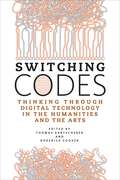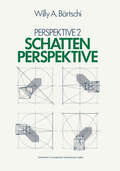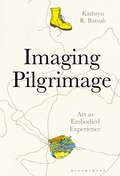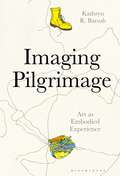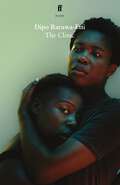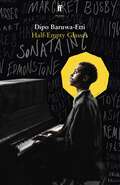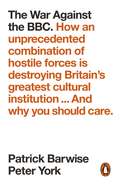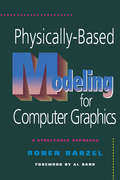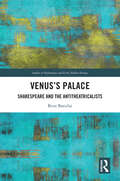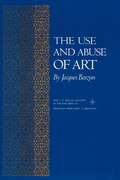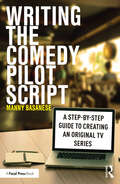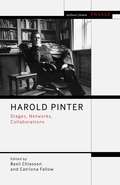- Table View
- List View
Switching Codes: Thinking Through Digital Technology in the Humanities and the Arts
by Thomas Bartscherer Roderick CooverHalf a century into the digital era, the profound impact of information technology on intellectual and cultural life is universally acknowledged but still poorly understood. The sheer complexity of the technology coupled with the rapid pace of change makes it increasingly difficult to establish common ground and to promote thoughtful discussion. Responding to this challenge, Switching Codes brings together leading American and European scholars, scientists, and artists—including Charles Bernstein, Ian Foster, Bruno Latour, Alan Liu, and Richard Powers—to consider how the precipitous growth of digital information and its associated technologies are transforming the ways we think and act. Employing a wide range of forms, including essay, dialogue, short fiction, and game design, this book aims to model and foster discussion between IT specialists, who typically have scant training in the humanities or traditional arts, and scholars and artists, who often understand little about the technologies that are so radically transforming their fields. Switching Codes will be an indispensable volume for anyone seeking to understand the impact of digital technology on contemporary culture, including scientists, educators, policymakers, and artists, alike.
Switching Codes: Thinking Through Digital Technology in the Humanities and the Arts
by Thomas Bartscherer Roderick CooverHalf a century into the digital era, the profound impact of information technology on intellectual and cultural life is universally acknowledged but still poorly understood. The sheer complexity of the technology coupled with the rapid pace of change makes it increasingly difficult to establish common ground and to promote thoughtful discussion. Responding to this challenge, Switching Codes brings together leading American and European scholars, scientists, and artists—including Charles Bernstein, Ian Foster, Bruno Latour, Alan Liu, and Richard Powers—to consider how the precipitous growth of digital information and its associated technologies are transforming the ways we think and act. Employing a wide range of forms, including essay, dialogue, short fiction, and game design, this book aims to model and foster discussion between IT specialists, who typically have scant training in the humanities or traditional arts, and scholars and artists, who often understand little about the technologies that are so radically transforming their fields. Switching Codes will be an indispensable volume for anyone seeking to understand the impact of digital technology on contemporary culture, including scientists, educators, policymakers, and artists, alike.
Schattenperspektive: Perspektive II
by Willy A. BärtschiDas Verständnis des Inhalts dieses Buches setzt die Kennt Kugel durchwegs kreisrund und nicht elliptisch im Umriß nis des Gesichtskreisverfahrens zur Konstruktion von Per wiedergegeben. Es ist ja außerdem so, daß wir uns instink spektiven voraus, das in meinem Buch "Perspektive" ein tiv dagegen sträuben, die Kugel -auch in der Perspektiv- gehend erklärt wird; denn im vorliegenden Buch geht es in der Form eines Ellipsoids darzustellen; denn ein solches um die Darstellung von Schattenperspektiven mit Hilfe des ist keine Kugel und diese ist kein Ellipsoid. Was Wunder, Gesichtskreisverfahrens. daß die Konstruktion der Kugel in der Perspektive in Lehr Während in der Linearperspektive die Dinge linear oder büchern dariiber nicht erklärt wird oder fehlt. Doch gerade bloß durch Linien dargestellt werden, läuft die Schatten dieser Sachverhalt war für mich ein Grund mehr, mich der Lösung dieses Problems besonders anzunehmen. Die Dar perspektive auf die Wiedergabe der gegenständlichen Welt mit Licht und Schatten oder mit hellen und dunklen Ton stellung der Kugel in der Perspektive und damit als Ellip werten hinaus. soid erweist sich aber auch dann als notwendig, wenn es Im 1. Teil dieses Buches werden die beleuchteten Partien darum geht, auf der beleuchteten Oberfläche des geraden der Oberfläche eines Körpers mit dem Papierton, die Ei Kreiskegels und Kreiszylinders die sogenannten Isophoten genschatten mit einem mittleren Grauton und die Schlag und im Zusammenhang damit die Tonstufen zu zeichnen. schatten mit Schwarz - im Ganzen also mit nur 3 Tonwer Dabei ist von der Kugel in der Perspektive auszugehen.
Visualization in Scientific Computing ’98: Proceedings of the Eurographics Workshop in Blaubeuren, Germany April 20–22, 1998 (Eurographics)
by Dirk Bartz9
Imaging Pilgrimage: Art as Embodied Experience
by Kathryn BarushWhile place-based pilgrimage is an embodied practice, can it be experienced in its fullness through built environments,assemblages of souvenirs, and music? Imaging Pilgrimage explores contemporary art that is created after a pilgrimage and intended to act as a catalyst for the embodied experience of others. Each chapter focuses on a contemporary artwork that links one landscape to another-from the Spanish Camino to a backyard in the Pacific Northwest, from Lourdes to South Africa, from Jerusalem to England, and from Ecuador to California. The close attention to context and experience allows for popular practices like the making of third-class or "contact" relics to augment conversations about the authenticity or perceived power of a replica or copy; it also challenges the tendency to think of the “original” in hierarchic terms.Imaging Pilgrimage brings various fields into conversation by offering a number of lenses and theoretical approaches (materialist, kinesthetic, haptic, synesthetic) that engage objects as radical sites of encounter, activated through religious and ritual praxis, and negotiated with not just the eyes, but a multiplicity of senses.
Imaging Pilgrimage: Art as Embodied Experience
by Kathryn BarushWhile place-based pilgrimage is an embodied practice, can it be experienced in its fullness through built environments,assemblages of souvenirs, and music? Imaging Pilgrimage explores contemporary art that is created after a pilgrimage and intended to act as a catalyst for the embodied experience of others. Each chapter focuses on a contemporary artwork that links one landscape to another-from the Spanish Camino to a backyard in the Pacific Northwest, from Lourdes to South Africa, from Jerusalem to England, and from Ecuador to California. The close attention to context and experience allows for popular practices like the making of third-class or "contact" relics to augment conversations about the authenticity or perceived power of a replica or copy; it also challenges the tendency to think of the “original” in hierarchic terms.Imaging Pilgrimage brings various fields into conversation by offering a number of lenses and theoretical approaches (materialist, kinesthetic, haptic, synesthetic) that engage objects as radical sites of encounter, activated through religious and ritual praxis, and negotiated with not just the eyes, but a multiplicity of senses.
The Clinic
by Dipo Baruwa-EttiI've given up on fighting for change.That's a strange, imperfect illusionthat allowed confusion to reign in my life.I took a knife to its neck and sliced it open.When a passionate activist, Wunmi, is invited into a middle-class Black family's home, a fire is lit. The family members have always seen themselves as pillars of society: they are charity workers, therapists and politicians. But as they begin to realise what Wunmi really represents, their certainty begins to crumble, the tension rises and a suffocating ash starts to fill the air. Full of forensic fury and incandescent poetry, Dipo Baruwa-Etti's fiercely political new play opened at the Almeida Theatre, London, in September 2022.
Half-Empty Glasses
by Dipo Baruwa-EttiI still play to their chords.Livin' within conventions.Livin' within restrictions.Livin' within a structure.Lettin' someone write my story.Toye is preparing for his piano exam to get into a prestigious music school. He's doing it for the contacts, the opportunity, the love of art. But when he notices the lack of Black British history in his school's curriculum, he begins to question himself and the world around him. Toye wants to follow his dream. but he can't let these institutions write his story. He decides to teach his classmates about Black cultural icons himself, but quickly discovers that not everyone wants Black historv to be celebrated.Dipo Baruwa-Etti's inspiring new play about the pressures of being young, gifted and ready to change the world premiered at Roundabout in Kingston, in a Paines Plough and Rose Theatre production, in July 2022.
The War Against the BBC: How an Unprecedented Combination of Hostile Forces Is Destroying Britain’s Greatest Cultural Institution... And Why You Should Care
by Patrick Barwise Peter YorkThere's a war on against the BBC. It is under threat as never before. And if we lose it, we won't get it back.The BBC is our most important cultural institution, our best-value entertainment provider, and the global face of Britain. It's our most trusted news source in a world of divisive disinformation. But it is facing relentless attacks by powerful commercial and political enemies, including deep funding cuts - much deeper than most people realise - with imminent further cuts threatened. This book busts the myths about the BBC and shows us how we can save it, before it's too late.
Physically-Based Modeling for Computer Graphics: A Structured Approach
by Ronen Barzel Alan H. BarrPhysically-Based Modeling for Computer Graphics: A Structured Approach addresses the challenge of designing and managing the complexity of physically-based models. This book will be of interest to researchers, computer graphics practitioners, mathematicians, engineers, animators, software developers and those interested in computer implementation and simulation of mathematical models.Presents a philosophy and terminology for "Structured Modeling"Includes mathematicl and programming techniques to support and implement the methodologyCovers a library of model components, including rigid-body kinematics, rigid-body dynamics, and force-based constraint methodsIncludes illustrations of several ample models created from these componentsForeword by Al Barr
Venus’s Palace: Shakespeare and the Antitheatricalists (Studies in Performance and Early Modern Drama)
by Reut BarzilaiThis book lays bare the dialogue between Shakespeare and critics of the stage, and positions it as part of an ongoing cultural, ethical, and psychological debate about the effects of performance on actors and on spectators. In so doing, the book makes a substantial contribution both to the study of representations of theatre in Shakespeare’s plays and to the understanding of ethical concerns about acting and spectating—then, and now. The book opens with a comprehensive and coherent analysis of the main early modern English anxieties about theatre and its power. These are read against 20th- and 21st-century theories of acting, interviews with actors, and research into the effects of media representation on spectator behaviour, all of which demonstrate the lingering relevance of antitheatrical claims and the personal and philosophical implications of acting and spectating. The main part of the book reveals Shakespeare’s responses to major antitheatrical claims about the powerful effects of poetry, music, playacting, and playgoing. It also demonstrates the evolution of Shakespeare’s view of these claims over the course of his career: from light-hearted parody in A Midsummer Night’s Dream, through systematic contemplation in Hamlet, to acceptance and dramatization in The Tempest. This study will be of great interest to scholars and students of theatre, English literature, history, and culture.
Venus’s Palace: Shakespeare and the Antitheatricalists (Studies in Performance and Early Modern Drama)
by Reut BarzilaiThis book lays bare the dialogue between Shakespeare and critics of the stage, and positions it as part of an ongoing cultural, ethical, and psychological debate about the effects of performance on actors and on spectators. In so doing, the book makes a substantial contribution both to the study of representations of theatre in Shakespeare’s plays and to the understanding of ethical concerns about acting and spectating—then, and now. The book opens with a comprehensive and coherent analysis of the main early modern English anxieties about theatre and its power. These are read against 20th- and 21st-century theories of acting, interviews with actors, and research into the effects of media representation on spectator behaviour, all of which demonstrate the lingering relevance of antitheatrical claims and the personal and philosophical implications of acting and spectating. The main part of the book reveals Shakespeare’s responses to major antitheatrical claims about the powerful effects of poetry, music, playacting, and playgoing. It also demonstrates the evolution of Shakespeare’s view of these claims over the course of his career: from light-hearted parody in A Midsummer Night’s Dream, through systematic contemplation in Hamlet, to acceptance and dramatization in The Tempest. This study will be of great interest to scholars and students of theatre, English literature, history, and culture.
The Use and Abuse of Art
by Jacques BarzunThe lecturer traces the historical development of attitudes toward the arts over the past 150 years, suggesting that the present is a period of cultural liquidation, nothing less than the ending of the modern age that began with the Renaissance.
The Use and Abuse of Art (The A. W. Mellon Lectures in the Fine Arts #73)
by Jacques BarzunThe lecturer traces the historical development of attitudes toward the arts over the past 150 years, suggesting that the present is a period of cultural liquidation, nothing less than the ending of the modern age that began with the Renaissance.
Design-Centered Entrepreneurship
by Min Basadur Michael GoldsbySupported by extensive research and field-testing, Design-Centered Entrepreneurship presents a concise, problem-solving approach to developing a unique business concept. Step-by-step guidelines provide insight into exploring market problem spaces, uncovering overlooked opportunities, reframing customer problems, and creating business solutions. Basadur and Goldsby present students with a creative and practical approach to problem finding, perception, organizational culture, and ethics in the entrepreneurial field. Plenty of useful diagrams help to organize key concepts, making them easily accessible to readers. Drawing on methodologies from the design field, the book will help students of entrepreneurship fill in the missing piece that transforms opportunity recognition into a viable business concept. Additional support for students and instructors, including a virtual Creative Problem Solving Profile, can be found at www.basadurprofile.com/.
Design-Centered Entrepreneurship
by Min Basadur Michael GoldsbySupported by extensive research and field-testing, Design-Centered Entrepreneurship presents a concise, problem-solving approach to developing a unique business concept. Step-by-step guidelines provide insight into exploring market problem spaces, uncovering overlooked opportunities, reframing customer problems, and creating business solutions. Basadur and Goldsby present students with a creative and practical approach to problem finding, perception, organizational culture, and ethics in the entrepreneurial field. Plenty of useful diagrams help to organize key concepts, making them easily accessible to readers. Drawing on methodologies from the design field, the book will help students of entrepreneurship fill in the missing piece that transforms opportunity recognition into a viable business concept. Additional support for students and instructors, including a virtual Creative Problem Solving Profile, can be found at www.basadurprofile.com/.
Design-Centered Entrepreneurship
by Min Basadur Michael Goldsby Rob MathewsGrounded in extensive research and field testing, Design-Centered Entrepreneurship presents a concise problem-solving approach to developing a unique business concept. Step-by-step guidelines provide insight into exploring market problem spaces, uncovering overlooked opportunities, reframing customer problems, creating business solutions, and sustaining success and an entrepreneurial culture. Drawing on methodologies from the world of design, the book helps students of entrepreneurship fill in the missing piece that transforms opportunity recognition into a viable business concept. Plenty of useful diagrams help to organize key concepts, making them easily accessible to readers. This second edition has been updated to include social entrepreneurship, more international examples and enhanced support materials. The digital supplements include a virtual creative problem-solving profile, slides, and an instructor manual. Design-Centered Entrepreneurship is the ideal text for entrepreneurship and new venture creation courses with a focus on design thinking.
Design-Centered Entrepreneurship
by Min Basadur Michael Goldsby Rob MathewsGrounded in extensive research and field testing, Design-Centered Entrepreneurship presents a concise problem-solving approach to developing a unique business concept. Step-by-step guidelines provide insight into exploring market problem spaces, uncovering overlooked opportunities, reframing customer problems, creating business solutions, and sustaining success and an entrepreneurial culture. Drawing on methodologies from the world of design, the book helps students of entrepreneurship fill in the missing piece that transforms opportunity recognition into a viable business concept. Plenty of useful diagrams help to organize key concepts, making them easily accessible to readers. This second edition has been updated to include social entrepreneurship, more international examples and enhanced support materials. The digital supplements include a virtual creative problem-solving profile, slides, and an instructor manual. Design-Centered Entrepreneurship is the ideal text for entrepreneurship and new venture creation courses with a focus on design thinking.
Writing the Comedy Pilot Script: A Step-by-Step Guide to Creating an Original TV Series
by Manny BasaneseNavigating through the challenging process of writing a comedy pilot, this book will help screenwriters to create an original script for television. Practical and accessible, the book presents a step-by-step guide focusing on the key elements of the process. Incorporating both the history of TV comedy as well as its current evolving state in this age of the dramedy and an ever-increasing variety of broadcast and streaming platforms, the book will serve as a guide for the fledgling sitcom scribe. Author Manny Basanese breaks down the comedy pilot writing process from what may be perceived as an overwhelming, time-consuming mission into a series of much more manageable, smaller steps (from logline to outline to 1st, 2nd and polished draft). Utilizing his experience in Hollywood’s sitcom trenches, the author offers real-world advice on such topics as building the comedy pilot "world," creating memorable comic characters, sound sitcom structure, and the importance of crafting an emotional through line in a comedy pilot. Finally, there is also practical career guidance for marketing this just-completed script and breaking into the industry with advice on various topics such as the value of networking as well as gaining representation in the competitive Hollywood jungle. It is ideal for students of screenwriting and aspiring comedy screenwriters.
Writing the Comedy Pilot Script: A Step-by-Step Guide to Creating an Original TV Series
by Manny BasaneseNavigating through the challenging process of writing a comedy pilot, this book will help screenwriters to create an original script for television. Practical and accessible, the book presents a step-by-step guide focusing on the key elements of the process. Incorporating both the history of TV comedy as well as its current evolving state in this age of the dramedy and an ever-increasing variety of broadcast and streaming platforms, the book will serve as a guide for the fledgling sitcom scribe. Author Manny Basanese breaks down the comedy pilot writing process from what may be perceived as an overwhelming, time-consuming mission into a series of much more manageable, smaller steps (from logline to outline to 1st, 2nd and polished draft). Utilizing his experience in Hollywood’s sitcom trenches, the author offers real-world advice on such topics as building the comedy pilot "world," creating memorable comic characters, sound sitcom structure, and the importance of crafting an emotional through line in a comedy pilot. Finally, there is also practical career guidance for marketing this just-completed script and breaking into the industry with advice on various topics such as the value of networking as well as gaining representation in the competitive Hollywood jungle. It is ideal for students of screenwriting and aspiring comedy screenwriters.
Fragile Werte: Diskurs und Praxis der Restaurierungswissenschaften 1913-2014 (Image #172)
by Nathalie Bäschlin»Fragil« nennen wir zerbrechliches Material ebenso wie verletzliche gesellschaftliche Konstitutionen. Das Fragile oszilliert dabei zwischen affirmativen Bewertungen und verunsichernden Konnotationen. Nathalie Bäschlin stellt die These auf, dass sich das Fragile zu einer eigenen Wertekategorie entwickelt hat, die unseren Blick auf die Kunst und die Formulierung des Bewahrungsauftrags nachhaltig beeinflusst. Sie fragt nach dem historischen Kontext, den Motivationen, die unsere Aufmerksamkeit auf das Fragile gelenkt haben, und wie die Auseinandersetzung mit der Fragilität die Praxis und den Diskurs des musealen Bewahrens durchdringt.
Basher Games: We've Got All the Best Moves!
by Simon Basher Tom JacksonWhat takes 2 people, 32 pieces and 64 squares? It’s chess, mate! How’s that for an opening gambit? This game of strategy has been around for thousands of years and it gives your brain a real workout. But you don’t have to be a brainiac to have fun playing chess, as Basher brings you his unique guide to the game that has experienced a huge surge in popularity in the last two years. Game on!First, get the basics with clear explanations of the pieces and how they move. Then move on to read about rules, strategy and famous games. You can also meet the world's chess greats, from the youngest-ever grand master, Abimanuyi Mishra, to current stars Magnus Carlsen and Judit Polgar.
Practical Numerical and Scientific Computing with MATLAB® and Python
by Eihab B. BashierPractical Numerical and Scientific Computing with MATLAB® and Python concentrates on the practical aspects of numerical analysis and linear and non-linear programming. It discusses the methods for solving different types of mathematical problems using MATLAB and Python. Although the book focuses on the approximation problem rather than on error analysis of mathematical problems, it provides practical ways to calculate errors. The book is divided into three parts, covering topics in numerical linear algebra, methods of interpolation, numerical differentiation and integration, solutions of differential equations, linear and non-linear programming problems, and optimal control problems. This book has the following advantages: It adopts the programming languages, MATLAB and Python, which are widely used among academics, scientists, and engineers, for ease of use and contain many libraries covering many scientific and engineering fields. It contains topics that are rarely found in other numerical analysis books, such as ill-conditioned linear systems and methods of regularization to stabilize their solutions, nonstandard finite differences methods for solutions of ordinary differential equations, and the computations of the optimal controls. It provides a practical explanation of how to apply these topics using MATLAB and Python. It discusses software libraries to solve mathematical problems, such as software Gekko, pulp, and pyomo. These libraries use Python for solutions to differential equations and static and dynamic optimization problems. Most programs in the book can be applied in versions prior to MATLAB 2017b and Python 3.7.4 without the need to modify these programs. This book is aimed at newcomers and middle-level students, as well as members of the scientific community who are interested in solving math problems using MATLAB or Python.
Practical Numerical and Scientific Computing with MATLAB® and Python
by Eihab B. BashierPractical Numerical and Scientific Computing with MATLAB® and Python concentrates on the practical aspects of numerical analysis and linear and non-linear programming. It discusses the methods for solving different types of mathematical problems using MATLAB and Python. Although the book focuses on the approximation problem rather than on error analysis of mathematical problems, it provides practical ways to calculate errors. The book is divided into three parts, covering topics in numerical linear algebra, methods of interpolation, numerical differentiation and integration, solutions of differential equations, linear and non-linear programming problems, and optimal control problems. This book has the following advantages: It adopts the programming languages, MATLAB and Python, which are widely used among academics, scientists, and engineers, for ease of use and contain many libraries covering many scientific and engineering fields. It contains topics that are rarely found in other numerical analysis books, such as ill-conditioned linear systems and methods of regularization to stabilize their solutions, nonstandard finite differences methods for solutions of ordinary differential equations, and the computations of the optimal controls. It provides a practical explanation of how to apply these topics using MATLAB and Python. It discusses software libraries to solve mathematical problems, such as software Gekko, pulp, and pyomo. These libraries use Python for solutions to differential equations and static and dynamic optimization problems. Most programs in the book can be applied in versions prior to MATLAB 2017b and Python 3.7.4 without the need to modify these programs. This book is aimed at newcomers and middle-level students, as well as members of the scientific community who are interested in solving math problems using MATLAB or Python.
Harold Pinter: Stages, Networks, Collaborations (Methuen Drama Engage)
by Basil Chiasson and Catriona FallowThis important book offers a thematic collection of critical essays, ideal for undergraduate courses on modern British theatre, on Harold Pinter's theatrical works, alongside new interviews with contemporary theatre practitioners. The life and works of Harold Pinter (1930–2008), a pivotal figure in British theatre, have been widely discussed, debated and celebrated internationally. For over five decades, Pinter's work traversed and redefined various forms and genres, constantly in dialogue with, and often impacting the work of, other writers, artists and activists. Combining a reconsideration of key Pinter scholarship with new contexts, voices and theoretical approaches, this book opens up fresh insights into the author's work, politics, collaborations and his enduring status as one of the world's foremost dramatists. Three sections re-contextualize Pinter as a cultural figure; explore and interrogate his influence on contemporary British playwriting; and offer a series of original interviews with theatre-makers engaging in the staging of Pinter's work today. Reconsiderations of Pinter's relationship to literary and theatrical movements such as Modernism and the Theatre of the Absurd; interrogations of the role of class, elitism and religious and cultural identity sit alongside chapters on Pinter's personal politics, specifically in relation to the Middle East.
